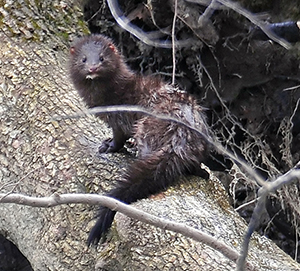Main Content
Article
Mink

Mink (Neovison vison) are one of Indiana’s “semi-aquatic” furbearers, meaning they spend much of their time in and around water. Members of the weasel family, mink are not seen often, though they are common throughout the state.
Are you a paddler interested in helping conserve and manage wildlife for future generations? Consider volunteering for the Paddlecraft Wildlife Index.
General description
- Mink have long bodies, bushy tails, and legs that are short compared to their body length.
- Males are larger than females, weighing 2–4 pounds and about 2 feet long including the tail. Mature females usually weigh about 1 1/2 to 2 pounds and are closer to a foot-and-a-half long including the tail.
- The bushy tail comprises about one-third of a mink’s length.
- Mink fur is a rich brown that darkens along the back, becoming almost black at the tip of the tail.
- Mink may have a white spot under the chin and white spots on the chest and belly.
- The head of a mink is small with low, rounded ears almost concealed in the dense fur.
Similar species
Distribution and abundance
Mink are found in all Indiana counties, but are most numerous where many ponds, streams and lakes occur. Mink are adapted to land and water, but usually make their homes near water’s edge. They are excellent swimmers and divers, but will travel into upland areas to hunt or find mates. Because of their secretive habits, there is a lot we don’t know about Indiana mink, but they seem most numerous in areas of high-quality wetlands.
Reproduction
Mink are primarily solitary except during breeding season. Mink breed in March, and the male does not help raise young. Mink dens may be located in hollow logs, bridge abutments, rock piles, ground burrows, or muskrat houses. Three to six young are born in late April or May, 42 days after conception. Newborns weigh only a quarter-ounce and are helpless. If disturbed, the female may move her young to another den. Their eyes open, and they begin to take solid food at about 1 month of age. They begin hunting with their mother two months after birth. The young in a litter break up from the family group during autumn to begin life on their own.
Food habits
Mink prefer fresh meat over carrion, but will sometimes store a carcass for a few days and continue consuming it. Mink get most of their food from the water, so primary foods include:
- Muskrats
- Fish
- Frogs
- Crayfish
- Snails
Mink will also eat:
- Small birds and waterfowl
- Small rodents
- Rabbits
Management and control
Regulated trapping continues to be an important tool in mink management. The perpetuation of quality wetland habitats is vital to the maintenance of mink populations as well as other aquatic furbearers. In some states mink have been susceptible to heavy metal contamination, so maintaining clean water is also critical to mink populations.
Resident landowners and tenants can trap or shoot a mink that is causing damage on their property. The mink must be euthanized or released within the county of capture on private property at which you have permission to release that animal. If you do not want to trap the mink yourself, contact a licensed nuisance wild animal control operator .
